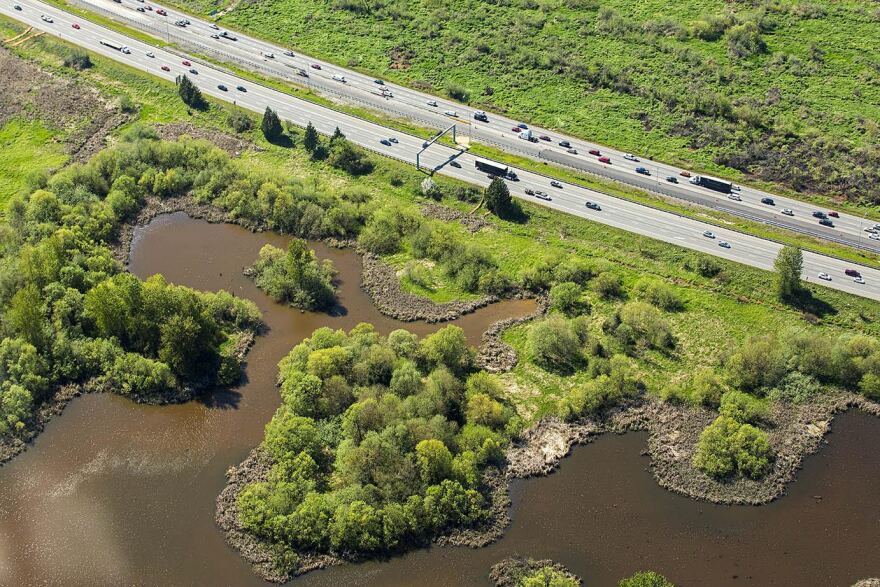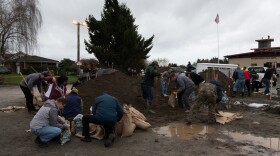For the first time, a river that connects Seattle and Tacoma has been included on a list of the 10 most endangered waterways in the country. American Rivers is highlighting the Green-Duwamish watershed this year. The national conservation group says the issue it wants addressed is outdated dams that lack passage for endangered fish.
The territory this river covers provides a rich study in contrasts. The headwaters start in the steep peaks of the Cascade Mountains, near Stampede Pass. From there, the Green winds down through forested foothills and carves its way into a lush river valley. It then passes through rich farmland that yields to a sprawling warehouse district before it reaches the heart of Seattle, where it ends in Puget Sound’s Elliot Bay.
Seeing it from above sounded like the best way to get an effective overview. So, I accepted the invitation to join a volunteer Lighthawk pilot and fly over in his tiny four-seater Cessna, with American Rivers campaign director Michael Garrity as a guide.
“The Green Duwamish is Seattle’s only river – and it’s got a lot of potential to again be a great salmon river and steelhead river,” Garrity said as we took off from Boeing Field and flew east, away from the industrial core of Seattle to where the once heavily polluted Duwamish joins the Green, to see that potential.
"Just above the Howard Hanson Dam there's about 40 miles of accessible habitat, so it's pretty extensive," Garrity said.
As the river flows through the warehouse districts of Kent and Auburn, you can see how it gradually changes from warm water that's been canalized and walled off by levies, into a cooler, winding ribbon that undulates freely across sandy banks and open land.

Garrity said on this middle portion of the Green, we were seeing a truly functional flood plain that provides plenty of places for migrating salmon to rest and spawn.
“That’s what a healthy river looks like,” he said, “with the logjams and the variety of habitat — and there’s shade in sections along the river and deep pools and all the complexity that you want.”
But that habitat ends once the river reaches two dams – dams that even Garrity acknowledges are important. One diverts drinking water for the city of Tacoma; the other protects several communities from chronic flooding.
As we fly over the huge Howard Hanson Dam and its reservoir, Garrity points out how a lot of the great restoration work that we were just seeing is being undermined, because there’s no downstream fish passage for hatchlings trying to get out.

“The problem today is there’s actually adult fish passage above the Tacoma Headworks dam that’s ready to go and start operating,” Garrity said. “But there’s no safe way out of the Howard Hanson reservoir for those salmons’ kids, basically.”
The obstacles on this river have led to historic-low returns of endangered salmon– as few as 800 Chinook coming back in recent years, despite longstanding plans for two federal agencies to fix it.
So, American Rivers is calling on the Army Corps of Engineers to get on with it, before the fish are gone for good. The Corps says they need additional congressional approval to fund the improvements, because the costs have ballooned. Still, Dan Johnson, the engineer with the Army Corps who operates the Howard Hanson Dam, says he actually thinks American Rivers’ spotlight could be helpful.
“I don’t see it as a negative thing, I think it’s important that groups like this recognize the importance of river systems," Johnson says. He doesn't dispute their claim that as much as 40 additional miles of habitat could be recolonized once effective passage is in place, even after nearly 100 years in which the dams cut migrating fish off from those areas.
“And when the Corps of Engineers has an opportunity to be part of it, we’ll do what we can to do the right thing,” he said, adding that they’re restricted in how much they can do by what Congress allows them to spend.
And now he says it’s not just Chinook salmon but also endangered steelhead they need to protect. Getting Congress to fund that work could be easier with American Rivers help. He says last year, their advocacy helped get fish passage funded on another local waterway, the Mud Mountain dam on the White River. So, he’s hopeful their work publicizing needs for the Green Duwamish will be productive as well. But he cautions, it will take years of study and hundreds of millions of dollars to get it all done.









